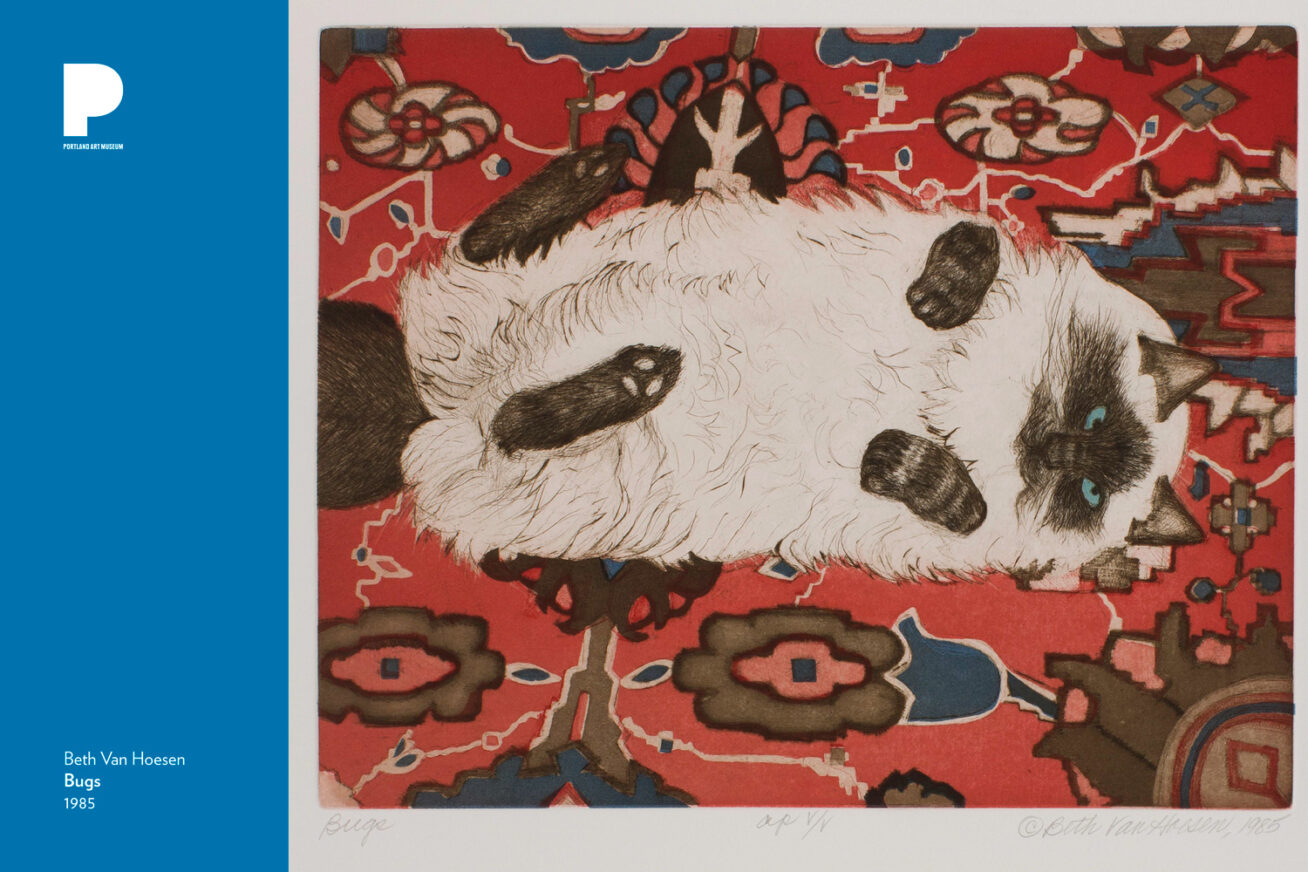
From her earliest days growing up on a farm in Idaho, Beth Van Hoesen always considered herself an artist. She exhibited a keen eye for nature and drawing, which she furthered first as an undergraduate at Stanford University, and subsequently at the California School of Fine Arts and at universities in both France and Mexico. She settled in San Francisco, where she enjoyed a long career as an artist. Her subjects were deceptively simple—portraits, still lifes, and animals dominate her oeuvre—but the power of her attention and strength of her draftsmanship add layers of complexity and meaning.
Van Hoesen is perhaps best known for her vivid depictions of animals, which started appearing more and more frequently in her work starting in the 1980s. She began each new project with meticulous observation: “When I draw an animal, I sit quietly, studying its movements, watching for the attitudes and positions that are unique to the particular animal. I look for poses that may be held for some time or returned to frequently. Often the studies start with many line drawings—small full figures or details of heads, paws—those things I think I need to study to understand.”
Bugs, the subject of this color etching, was the cat of Van Hoesen’s printer, Tim Berry. Van Hoesen asked Berry to bring Bugs to her home, where he promptly flopped on the rug and rolled on his back. Van Hoesen masterfully captured the repose of the fluffy feline. The textures of fur, claw, and whisker compete for our attention, as do the cat’s slightly crossed blue eyes, which regard the viewer in a steady gaze. The patterning of the rug adds vivid color and motion in contrast to Bugs’s stationary pose. As in her other works, the relationship of the subject (in this case, Bugs) to the background (the Oriental rug) was of utmost importance. The perspective, too, animates the print: we appear to view Bugs from directly above, while the carpet appears at a slightly oblique angle, creating the faint impression of movement or sliding.
Bugs exudes personality through his pose, the markings of his fur, the set of his ears, and his facial expression. At times, Van Hoesen was accused of anthropomorphizing her animal subjects, a charge that she steadfastly resisted, replying: “No, I only put in what I see. Have you ever looked at an animal for 10 days? If you did, you will find many expressions and each one is an individual.” Moreover, she was respectful of the wildness of the creatures she depicted, recognizing the human/animal divide despite the great affection and proximity we may share with them. These are no Disney animations, but exacting portraits of distinct, individual beasts.
Discussion and activities
- Van Hoesen aspired to capture Bugs’s personality. What adjectives would you use to describe him? His owners described him in the following quote. How does his personality shine through in his portrait?
“He has always been peculiar and seems to meditate a lot. I call him the Mahatma because of his nonviolent response to aggression in other animals. He has never been in a fight and has stared down the meanest of adversaries, from German shepherds to tomcats. They just back off.
“Most of the time, Bugs sleeps upside down with his feet up in the air—like in the print. He lumbers around slowly, doesn’t care about birds or other cat things… He is a strange cat, who seems to combine a deep wisdom with some sort of profound dumbness.” - Imagine the texture of Bugs’s fur and the carpet he lies on. How would you describe them? What do you notice about the patterns and colors in this image?
- What do you think is happening outside the frame of this picture? What happened before or happens next? Write a story about Bugs.
- Compare this portrait of Bugs to representations of animals in other Poster Project works, such as the kkokdu or Leticia Tarragó’s prints? What differences and similarities do you notice in how these artists portray animals? What makes them seem real or imaginary, individual or a type?
- How would you portray a pet or other animal in your life? Think about their character traits and preferences. Where do they like to nap or play? What pose best conveys your animal’s personality? Then, create a portrait with any materials you choose.
Selected sources
Beth Van Hoesen, Creatures. The Art of Seeing Animals: Prints Drawings, and Watercolors (San Francisco: Chronicle Books, 1987), 98, 44.
Bob Hicks, “Beth Van Hoesen: Becoming Perfect,” in Beth Van Hoesen: Catalogue Raisonné of Limited-Edition Prints, Books, and Portfolios (Manchester and New York: Hudson Hills Press, 2011): 21.